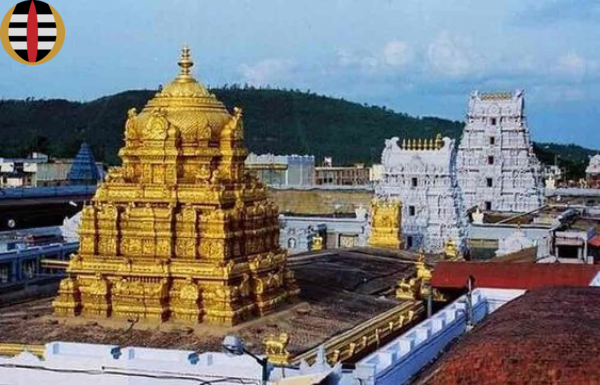Sri Venkateswara Swamy Vaari Temple, Tirumala
(IPLTOURS)
The eight shrines where are said to be Srirangam, Thirumala, Kallahalli, Tirunelveli, Nepal, Pushkar, Naimisharanyam and Badrinath. Sri Venkateswara Swami Kaliyuga originated on earth in Thirumala at the beginning of Kali Era. Lord Vishnu originated as Sri Ranganatha Swamy of Srirangam, Bhu Varahaswamy of Kallahalli, Sri Thothadri Nadhan of Tirunalveli, Mukthinath in Nepal, Varahaswamy in Puskar, Lakshminaraya in Naimisharanya and Badari Narayan in Badrinath in Krutha, Threta and Dwapara Eras. Tirumala has a special place in the eight shrines. Thirumala Sri Venkateswara is the first among the twelve richest temples of our country. Srinivasa has about eight hundred tons of gold and deposits of about Rs 1,092 crores in various banks. Millions of devotees regularly visit the Sri Venkateswara Temple in Thirumala and offer offerings and offerings to the Lord.
Tirumala has a remarkable reputation since ancient times. Lord Venkateswara is the incarnation of Lord Vishnu incarnated in Kali Era to destroy the sins of human beings. He may be called with any name viza., Srinivasa, Govinda, Kesava, Anantha, Apada Mokkulavada. Northern people of our country worship with the name of Balaji. The legendary deity established 2800 feet above sea level on the Tirumala Hills, known to be Seshachalam Hills of the Eastern Ghats. Lord Venkateswara established at Thirumala known as Kaliyuga Vaikunth on the Seshachal hills spread over seven peaks with seven heads of Adisesha. The Seshachal hills are arches, up and downs and the waterfalls resembles Adi Seshu bed of Lord Vishnu. On the way from Tirupati to Tirumala, the hills are like the seven heads of Adisheshu, Ahobilam is seems the center of Adisheshu and Srisailam referring to the tail end of Adisheshu and Tirumala is called Seshachalam.
According to the legend, Tirumala was a holy place and was known with the names of Vrishabhachala, Anjanachala and Sheshachala respectively during the Krita, Treta and Dwapara eras and Venkatachala in Kaliyuga. After the completion of the incarnation of Lord Krishna in the Dvapara era and at the beginning of the Kaliyug, Lord Vishnu came in the form of Srinivasa and settled on the Seshachala hills.
Lord Venkateswara placed Goddess Lakshmi on his heart and become as stone idol blessing the devotees with consorts Bhudevi and Padmavati. Venkateswara is the deity of the Hindu Brahmins known as the Gowda Saraswati Brahmins who are famous in the states of Karnataka, Goa, Maharashtra and Kerala. Swami is called Venkatachalapati or Venkataramana or Thirumal Devar or Varadaraju or Srinivasa or Balaji or Bitala. The Lord appears in black color with four hands wearing chakra and conch in the upper hands. The lower two hands ask the devotees to surrender for their protection. Every Gowda Saraswati Brahmin is eager to visit Lord Srinivasa once in a lifetime.
The Tirupati town abode of Sri Govindaraja Swamy, brother of Lord Venkateswara is located at the foot of the Thirumala Hills in Tirupati Corporation of Chittoor district in Andhra Pradesh. Unlike other Vishnu temples, small sub-temples and other idols are not found in the temple except the idol of Lord Venkateswara. There is no temple even to the Goddess in the complex.
A small idol resembling the original form of Sri Venkateswara in a small shrine adorned with a silver Capricorn arch on the dome known as “Vimana Venkateswara” is seen served by Garutmanta and Hanuman on both sides. The idol is said to have been erected by Emperor Thondaman mentioned in the “Venkatachala Mahatyam”. Devotees believe that the vision of Vimana Venkateswara is similar to the vision of Moola Virat. Devotees who could not visit Moola Virat may visit Vimana Venkateswara and the result of the pilgrimage will be succeeded. Devotees used to visit Moola Virat after visiting Vimana Venkateswara while circling around the dome earlier, but now due to rush devotees are visiting Moola Virat first and then Vimana Venkateswara. Vimana Venkateswara Darshan gives liberation from all sins and offers radiant life. Alayappa Swamy with his concerts Sridevi and Bhudevi stands in the presence of Vimana Venkateswara and take harathi before going on procession from the temple. Sacred garlands are also offered to the Vimana Venkateswara during the three-day holy festival once a year. Priests submit offerings three times a day to Vimana Venkateswara on the outside of the Ananda Nilayam while presenting to the Moola Virat. Due to the congestion, there is not enough time for Venkateswara Darshan in the sanctum.
Lord Venkateswara Temple, Pushkarini, Papanasam, Varahaswamy Temple, Sila Thoranam which is an ancient stone structure built 10,000 years ago and Akasa Ganga waterfalls are the visiting places to see in Thirumala. The temple has set up a free bus service to visit these places for the convenience of pilgrims. Sri Ramanujacharya nominated five abbots to formulate and supervise the rituals in Tirumala. Lord Venkateswara attracts the devotees at the first instance and the devotees will be attracted to visit the temple repeatedly. Legend is that Lord Venkateswara protects his devotees in Kali Yug. None of the devotees will turn away with dissatisfaction.
The Tirumala Tirupati Temple is managed by an administrative board appointed by the Government of Andhra Pradesh. The temple has a number of guest houses, rooms and cottages that they operate in Tirupati at the bottom of the hill and in Tirumala on the hill. Bookings can be made up 60 days in advance by booking through online. All the Towns and cities of our country are well connected with Tirupati by rail, bus and air. Thousands of tourists regularly visit Tirumala in tourist buses from different parts of the country. The temple provides food under the free donation scheme to all the devotees who come to see Lord Venkateswara. Accommodation and meals facilities are available separately at Annadana Satra for all castes in Tirupati. Swami Darshan is allowed in various services from 2-30 in the morning to 12-00 at night. Visit Tirupati Yatra page at ipltours.in for the field story.




